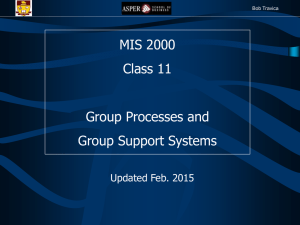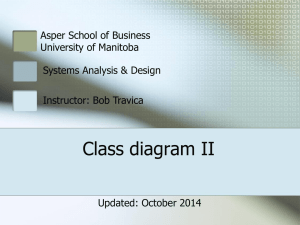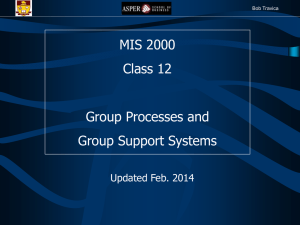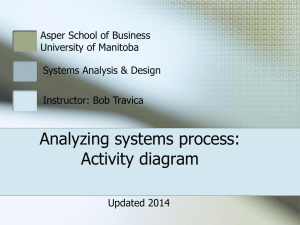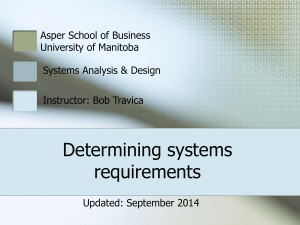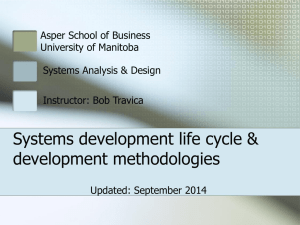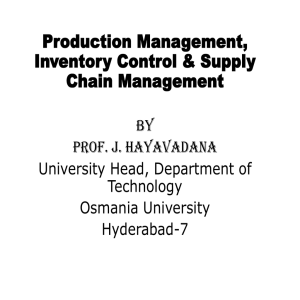Supply Chain Processes and Systems
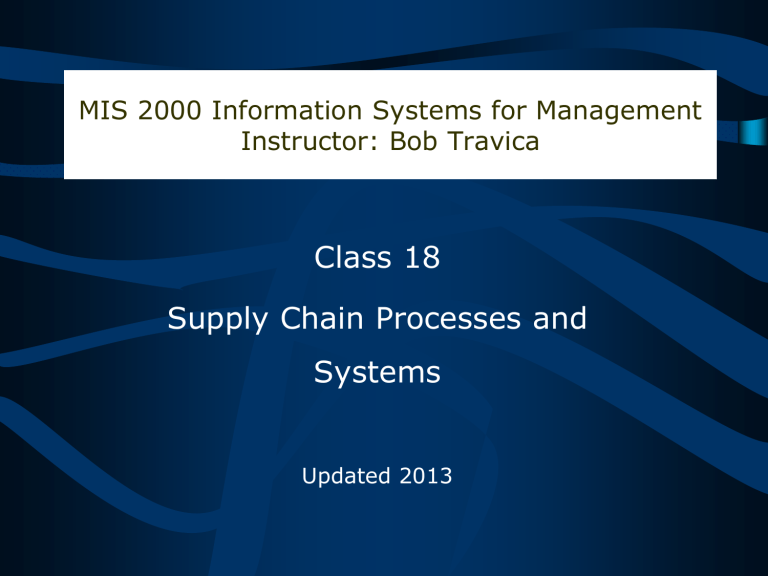
Bob Travica
MIS 2000 Information Systems for Management
Instructor: Bob Travica
Class 18
Supply Chain Processes and
Systems
Updated 2013
Outline
• Supply Chain Concepts (general process, upstream & downstream chain, purchasing and delivery)
• Supply Chain Process – Single Firm View
• Supply Chain Process – Multiple Firm View
• Electronic Supply Chain
• Summary
Bob Travica
2 of 12
Supply Chain Process – Single Firm View
Bob Travica
Plan production
Inventory proc.
Source
(Purchase) materials
Purchasing proc.
Make product
Sell + handle returns
Returns?
Deliver
N
Y
Delivery proc.:
Scheduling,
Transporting,
Warehousing
• Definition: Supply chain refers to the players, activities and resources involved in producing and transferring a good or service to a customer.
• Supply chain management (SCM) is an area of business focused on managing supply chain.
• SCM usually focuses on inventory, purchasing, & delivery
(boxed above).
More
3 of 12
Bob Travica
Upstream And Downstream Chain, and
Key Processes (Purchasing & Delivery)
Purchasing
Dept.
Inventory
Dept.
Suppliers FIRM Customers
Purchasing
Process
Upstream chain
Data flow
Material flow
Delivery
Process
(Shipping dept. or 3 rd party)
Downstream chain
Data flow
Material flow
• Note that delivery is involved both downstream and upstream delivery from supplier to buyer firm).
A very important complex process, composed of several sub-processes (scheduling, shipping, warehousing).*
• SC is maintained via communication upstream & downstream.
4 of 12
Inventory
Bob Travica
Supply Chain Process –
A Single Firm View
Communication,
Inventory
Communication
Walmart’s
Supplier
P&G Suppliers:
Inventory,
Production,
Suppliers:
Delivery
Note the linking on the focal firm’s back-end: on Walmart side, Sales trigger
Inventory & Purchasing, which on P&G side triggers Purchasing & Delivery.
5 of 12
Purchasing Process
• Purchasing is important because it feeds many org. functions.
• To make all departments work, data need to flow seamlessly through an organization.
• Integration of departmental IS (systems integration) is needed.
Production operations
Inventory
Bob Travica
6 of 12
• Example:
SC for a pop (soda) drink
• All perform
Delivery.
Logistics firms provide support.
• Note the complexity!
Bob Travica
Supply Chain Process – Multiple Firm View
S
S
C
R
D
M
M D
S Upstream chain
S
M
Focal firm
D
R
C
Down-
Stream chain
R C
More
7 of 12
• Multiple-firm SC example: SC for beer producer
Bob Travica
• Creation and transfer of business documents, and all communication and payments can be supported by IS.
8 of 12
Bob Travica
Electronic Supply Chain (e-SC)
• SC costs directly affect profit, thus savings in SC increase profit. The effect is larger than the increased sales have on profit.
• Trend is the electronic SC (e-SC), which increases these benefits. Communication around SC is electronic, which implies that business documents are also electronic. (See slide 5,
Walmart—Proctor & Gamble)
• Various kinds of IT and IS used in e-SC:
– EDI
– ERPS=Enterprise Resource Planning System (ERPS)*
– private computer networks & Internet
– Purchasing & Inventory TPS/MIS
– DSS for optimizing delivery (timing, loads, routes)
– TPS for delivery tracking
More
9 of 12
Bob Travica
Electronic Supply Chain (e-SC)
• E-marketplaces may be involved (part of B2B e-commerce) as connection between the buyer and supplier firms.
• Logistics firms are important in e-SC (FedEx, UPS, DHL). They connect, track, and perform some special activities for producers.*
• e-Sc does:
– automating processes
– connecting SC members
– increasing visibility in SC
– enabling closer coordination among members
More
10 of 12
Bob Travica
Electronic Supply Chain (e-SC)
• The e-SC creates savings for the focal firm by decreasing:
– time (production time due to fast supplies*, wait time in warehouses, document transfer time; overall time-to-market)
– cost (labor, wasted load space in transport, interest on loans taken for production**)
– errors & coordination losses (accuracy of all data increased, better timing of related activities)
– likelihood of customer’s switching to a new supplier.
• From the customer perspective, electronic SC can increase the value by providing products faster and cheaper.
• Here is an article on SC and SC systems.
11 of 12
Bob Travica
Summary
• Supply chain (SC) refers to all players, activities and resources involved in producing and transferring a good or service to a customer.
• SC process is a complex, even in single firm view (many connections in process composition, hierarchical dependencies, and coordination in timing matters).
• SC savings increase profit for seller and value for customer.
Trend is electronic SC (e-SC) which increases these benefits.
• The e-SC deploys various IS and telecommunications networks
(EDI, ERPS, private networks and Internet, TPS for flow tracking, Purchasing TPS/MIS) as well as complex systems structures embedded in e-markets (the master case).
12 of 12
